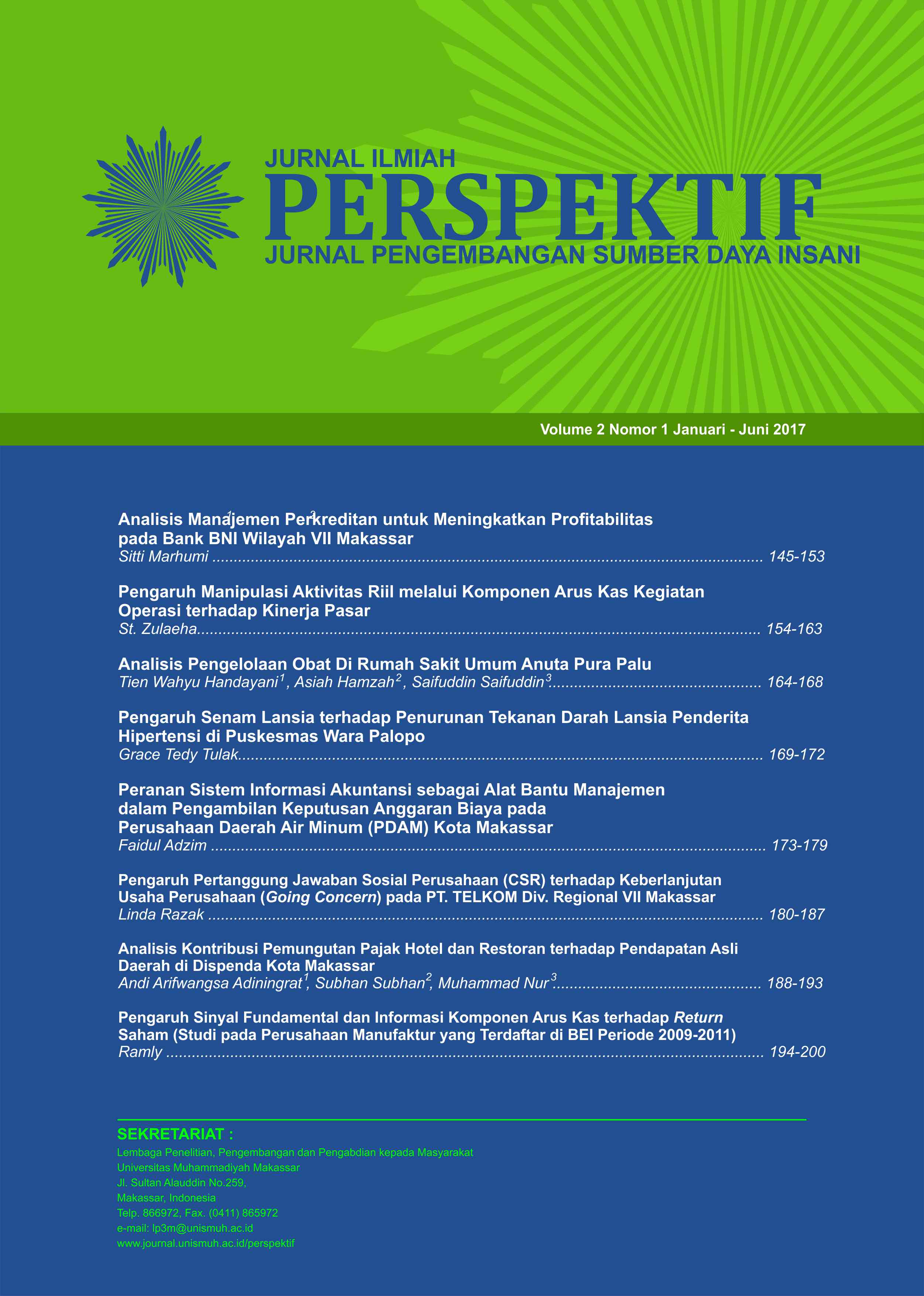Pengaruh Sinyal Fundamental dan Informasi Komponen Arus Kas terhadap Return Saham (Studi pada Perusahaan Manufaktur yang Terdaftar di BEI Periode 2009-2011)
DOI:
https://doi.org/10.26618/perspektif.v2i1.585Keywords:
Fundamental Signals, Information of Cash Flow Component, Stock ReturnAbstract
Failure of earnings reflects stock prices fully implies there is other information that can be used to invest. This aims to research were to investigate alternative information of non-profit (earning) in investing by examining (1) relationship between fundamental signals (accounts receivable, inventory, gross margin, sales and administrative expenses, effective tax rate, labor force and capital expenditure)and stock returns, and (2) the information of cash flow component (operating cash flows, investing cash flows and financing cash flow)on stock return. The research was conducted on the Indonesia Stock Exchange (IDX) using secondary data. The samples were selected using purposive sampling method consisting of 105 data observed from 2009 to 2011. The data were analyzed using multiple linear analysis. The results of the research indicate that fundamental signals such as inventory, gross margin, sales and administrative expenses and capital expenditure have a significant influence on stock returns, while the fundamental signals such as accounts receivable, effective tax rate, and labor force indicate an insignificant influence. Similarly, information of cash flow components such as operating cash flows, investing cash flows and financing cash flow indicate an insignificant influence either. Based on the results of these studies we can conclude that the fundamental signals such as inventory, gross margin, sales and administrative expenses and capital expenditure information can be used as an alternative to investing.References
Abarbanel. J; Busshee. (1997). Fundamental Analysis, Future Earnings, Stock prices. Journal of Accounting Research 35 (Spring): 1-24
Abarbanel. J; Busshee. (1998). Abnormal Return to A Fundamental Analysis Startegy. The Accounting Review. 73 January: 19-45
Amir, Eli; Lev, Baruch, (1996). Value-Relevance of non financial information: The Wireless Communication industry. Journal of accounting and Economic. 22. 3-30
Ball, R.; Brown, P. (1968). An Empirical Evaluation of Accounting Income Numbers. Journal of Accounting Research (Autumn). pp. 159-177.
Barlev, Benzion; Livnat, Joshua. (1989). The Incremental Content Of Fund Statement Ratios. Journal Accounting, Auditing, and Finance, pp.155-192
Beaver, W. H. (1968). The Inforniation Content of Annual Earnings Announcements. Journal of Accounting Research 6: 67-92.
Bernard, Victor; Thomas, Jacob .(1990). Evidence that stock do not fully reflect the implications of current earning for future earning. Elsevier Sience publisher B.V. (North Holand).
Bernard, V. L.; Stober, T. L. (1989). The Nature and Ammount of Information in Cash Flows and Accruals. The Accounting Review 64 (October): 624-652.
Bowen, Robert M.; David Burgsthler; Lane A. Daley. (1986). Evidence on The Relationships between Earnings and Variouss Measures of Cash Flows. The Accounting Review Vol XI No.4 (October): 213-225.
Elleuch, Jaouida; Trabelsi, Lotfi. (2009). Fundamental Analysis Strategy and the Prediction of Stock Returns. International Research Journal of Finance and Economics ISSN 1450-2887 Issue 30.
Jogiyanto H.M. (2008). Teori Portofolio dan Analisis Investasi. Edisi 7. BPFE. Yogyakarta
Jogiyanto H.M. (2012). Pasar Efisien secara Informasi, Operasional, dan Keputusan, Edisi 2. BPFE. Yogyakarta.
Kargin, Sibel. (2013). The Impact of IFRS on the Value Relevance of Accounting Information: Evidence from Turkish Firms. International Journal of Economics and Finance; Vol. 5, No. 4
Lev, Baruch; Tiagarajan, S.R. (1993). Fundamental Information Analysis. Journal Of Accounting Research Vol. 31 No. 2 Autumn.
Livnat, Joshua; Zarowin, Paul. (1990). The Incremental Content of Cash Flow. Journal of Accounting and Economic: 25-46.
Luch, Crish; Maheshwari, Suneel; Myring, Mark. (2011). An examination of future firm performance and fundamental analysis. Journal of Finance and Accountancy
Manurung, A.M. (2012). Teori Investasi: Konsep dan Empiris. STIEP Press. Jakarta
Marfuah. (2006). Pengaruh Kecanggihan Investor Terhadap Ketepatan Reaksi Pasar Dalam Merespon Pengumuman Dividen Meningkat. JAAI. Volume 10 NO. 2: 137-154
Ou. J.; Penman, S. (1989). Financial Statement Analysis And Prediction Of Stock Return. Journal Of Accounting And Economic. (11 November): 295-330.
Rayburn, Judy. (1986). The Association of Operating Cash Flowsand Accruals with Security Return. Journal of Accounting Research 24:112-138
Reilly, F.K; Brown, K.C. (2006). Investment Analysis And Portfolio Management 8th, ed. Thomson South-Western.
Sharma, Meena; Preeti. (2009). Prediction Of Stock Returns For Growth Firm: A fundametal Analysis. The Journal of Business Perspective, Volume 13. No. 3
Seng, Dyna; Hancock, Jason. (2012). Fundamental Analysis and the Prediction Of Earnings. International Journal Of Busisness and Management.
Shen, Chung-Hua; Li Lin, Kun. (2010). The Impact of Corporate Governance on the Relationship Between Fundamental Information Analysis and Stock Returns Emerging Markets Finance & Trade Vol. 46, No. 5, pp. 90–105
Suryaningrum, Anik; Jogiyanto, H.M. (2000). Abnormal Return Dengan Startegi Analisis Fundamental. SOSIOHUMANIKA, 13(3) September 2000.
Subramanyam K.R; Wild, John. (2010). Financial Statement Analysis. Salemba Empat Edisi Ke 10. Jakarta
Wilson, G.P. (1986). The Relative Information Content of Accruals and Cash Flows: Combined Evidence at the Earnings Announcement and Annual Report Release Date. Journal of Accounting Research Vol. 24
Downloads
Published
Issue
Section
License

This work is licensed under a Creative Commons Attribution-ShareAlike 4.0 International License.

